Financial Accounting Assignment: Statement Analysis and Theory
VerifiedAdded on 2020/04/21
|12
|1606
|71
Homework Assignment
AI Summary
This financial accounting assignment provides a comprehensive analysis of financial statements and related accounting theory. The assignment includes detailed entries for a company's financial transactions from January to June, covering profit and loss statements and balance sheets for each month. The solution demonstrates the calculation of revenue, expenses, and profits, along with the presentation of assets, liabilities, and shareholder's equity. In addition to the practical exercises, the assignment also includes a theoretical section defining financial accounting, explaining the components of financial statements like balance sheets, income statements, and cash flow statements, and differentiating between profit, revenue, and cash. The assignment is a valuable resource for students studying financial accounting and is available on Desklib, a platform that provides AI-based study tools.
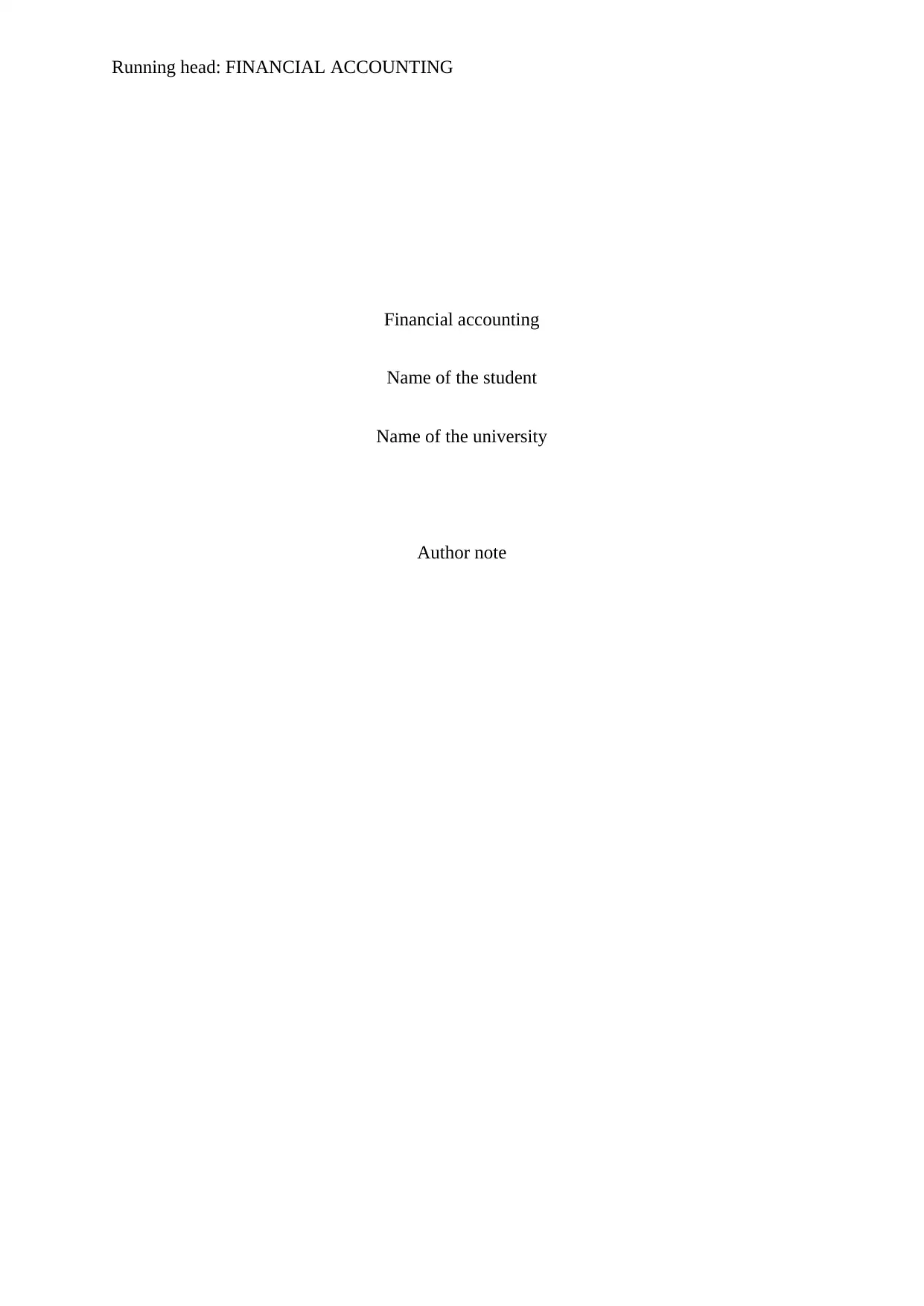
Running head: FINANCIAL ACCOUNTING
Financial accounting
Name of the student
Name of the university
Author note
Financial accounting
Name of the student
Name of the university
Author note
Paraphrase This Document
Need a fresh take? Get an instant paraphrase of this document with our AI Paraphraser
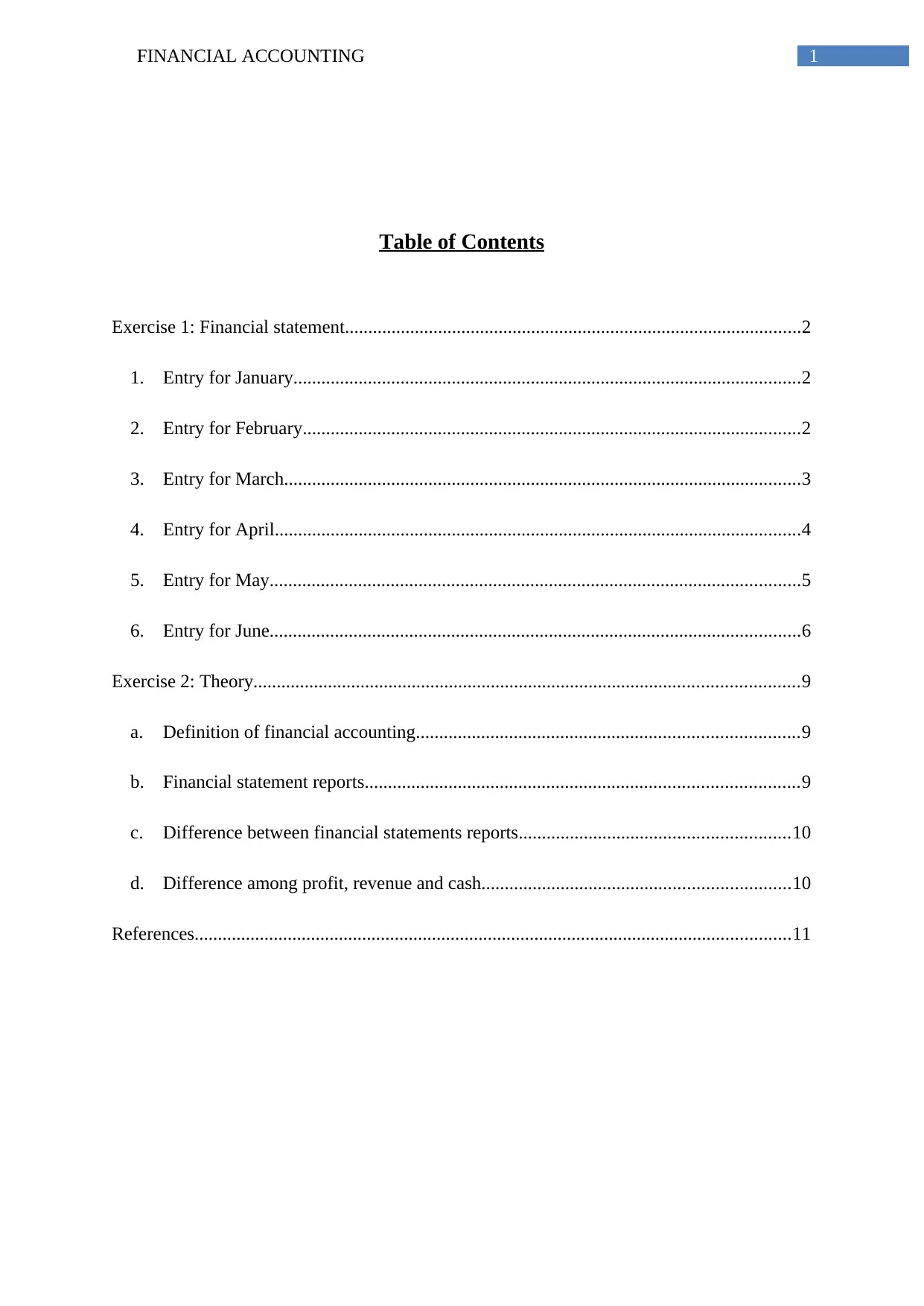
1FINANCIAL ACCOUNTING
Table of Contents
Exercise 1: Financial statement..................................................................................................2
1. Entry for January.............................................................................................................2
2. Entry for February...........................................................................................................2
3. Entry for March...............................................................................................................3
4. Entry for April.................................................................................................................4
5. Entry for May..................................................................................................................5
6. Entry for June..................................................................................................................6
Exercise 2: Theory.....................................................................................................................9
a. Definition of financial accounting..................................................................................9
b. Financial statement reports.............................................................................................9
c. Difference between financial statements reports..........................................................10
d. Difference among profit, revenue and cash..................................................................10
References................................................................................................................................11
Table of Contents
Exercise 1: Financial statement..................................................................................................2
1. Entry for January.............................................................................................................2
2. Entry for February...........................................................................................................2
3. Entry for March...............................................................................................................3
4. Entry for April.................................................................................................................4
5. Entry for May..................................................................................................................5
6. Entry for June..................................................................................................................6
Exercise 2: Theory.....................................................................................................................9
a. Definition of financial accounting..................................................................................9
b. Financial statement reports.............................................................................................9
c. Difference between financial statements reports..........................................................10
d. Difference among profit, revenue and cash..................................................................10
References................................................................................................................................11
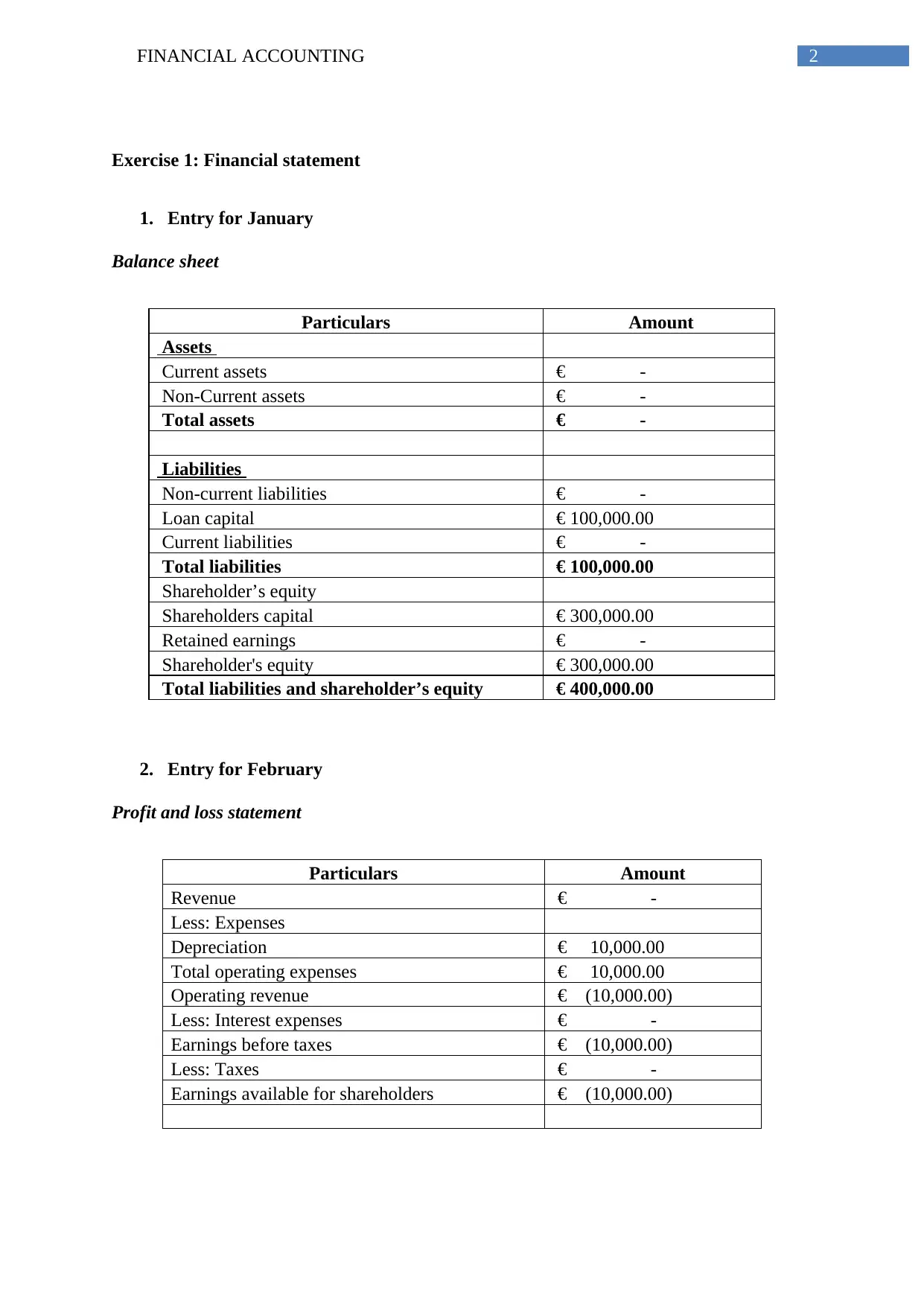
2FINANCIAL ACCOUNTING
Exercise 1: Financial statement
1. Entry for January
Balance sheet
Particulars Amount
Assets
Current assets € -
Non-Current assets € -
Total assets € -
Liabilities
Non-current liabilities € -
Loan capital € 100,000.00
Current liabilities € -
Total liabilities € 100,000.00
Shareholder’s equity
Shareholders capital € 300,000.00
Retained earnings € -
Shareholder's equity € 300,000.00
Total liabilities and shareholder’s equity € 400,000.00
2. Entry for February
Profit and loss statement
Particulars Amount
Revenue € -
Less: Expenses
Depreciation € 10,000.00
Total operating expenses € 10,000.00
Operating revenue € (10,000.00)
Less: Interest expenses € -
Earnings before taxes € (10,000.00)
Less: Taxes € -
Earnings available for shareholders € (10,000.00)
Exercise 1: Financial statement
1. Entry for January
Balance sheet
Particulars Amount
Assets
Current assets € -
Non-Current assets € -
Total assets € -
Liabilities
Non-current liabilities € -
Loan capital € 100,000.00
Current liabilities € -
Total liabilities € 100,000.00
Shareholder’s equity
Shareholders capital € 300,000.00
Retained earnings € -
Shareholder's equity € 300,000.00
Total liabilities and shareholder’s equity € 400,000.00
2. Entry for February
Profit and loss statement
Particulars Amount
Revenue € -
Less: Expenses
Depreciation € 10,000.00
Total operating expenses € 10,000.00
Operating revenue € (10,000.00)
Less: Interest expenses € -
Earnings before taxes € (10,000.00)
Less: Taxes € -
Earnings available for shareholders € (10,000.00)
⊘ This is a preview!⊘
Do you want full access?
Subscribe today to unlock all pages.

Trusted by 1+ million students worldwide
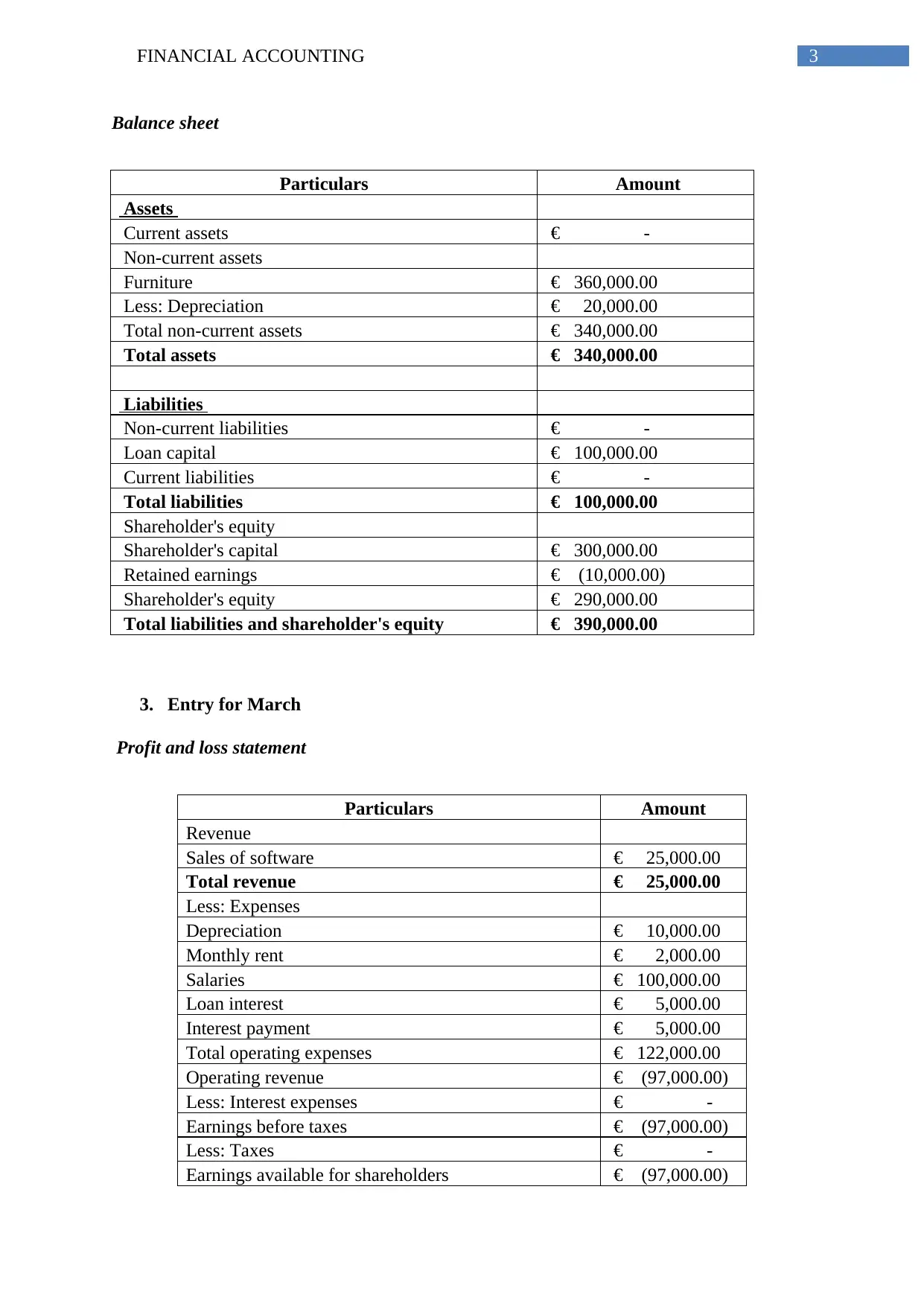
3FINANCIAL ACCOUNTING
Balance sheet
Particulars Amount
Assets
Current assets € -
Non-current assets
Furniture € 360,000.00
Less: Depreciation € 20,000.00
Total non-current assets € 340,000.00
Total assets € 340,000.00
Liabilities
Non-current liabilities € -
Loan capital € 100,000.00
Current liabilities € -
Total liabilities € 100,000.00
Shareholder's equity
Shareholder's capital € 300,000.00
Retained earnings € (10,000.00)
Shareholder's equity € 290,000.00
Total liabilities and shareholder's equity € 390,000.00
3. Entry for March
Profit and loss statement
Particulars Amount
Revenue
Sales of software € 25,000.00
Total revenue € 25,000.00
Less: Expenses
Depreciation € 10,000.00
Monthly rent € 2,000.00
Salaries € 100,000.00
Loan interest € 5,000.00
Interest payment € 5,000.00
Total operating expenses € 122,000.00
Operating revenue € (97,000.00)
Less: Interest expenses € -
Earnings before taxes € (97,000.00)
Less: Taxes € -
Earnings available for shareholders € (97,000.00)
Balance sheet
Particulars Amount
Assets
Current assets € -
Non-current assets
Furniture € 360,000.00
Less: Depreciation € 20,000.00
Total non-current assets € 340,000.00
Total assets € 340,000.00
Liabilities
Non-current liabilities € -
Loan capital € 100,000.00
Current liabilities € -
Total liabilities € 100,000.00
Shareholder's equity
Shareholder's capital € 300,000.00
Retained earnings € (10,000.00)
Shareholder's equity € 290,000.00
Total liabilities and shareholder's equity € 390,000.00
3. Entry for March
Profit and loss statement
Particulars Amount
Revenue
Sales of software € 25,000.00
Total revenue € 25,000.00
Less: Expenses
Depreciation € 10,000.00
Monthly rent € 2,000.00
Salaries € 100,000.00
Loan interest € 5,000.00
Interest payment € 5,000.00
Total operating expenses € 122,000.00
Operating revenue € (97,000.00)
Less: Interest expenses € -
Earnings before taxes € (97,000.00)
Less: Taxes € -
Earnings available for shareholders € (97,000.00)
Paraphrase This Document
Need a fresh take? Get an instant paraphrase of this document with our AI Paraphraser
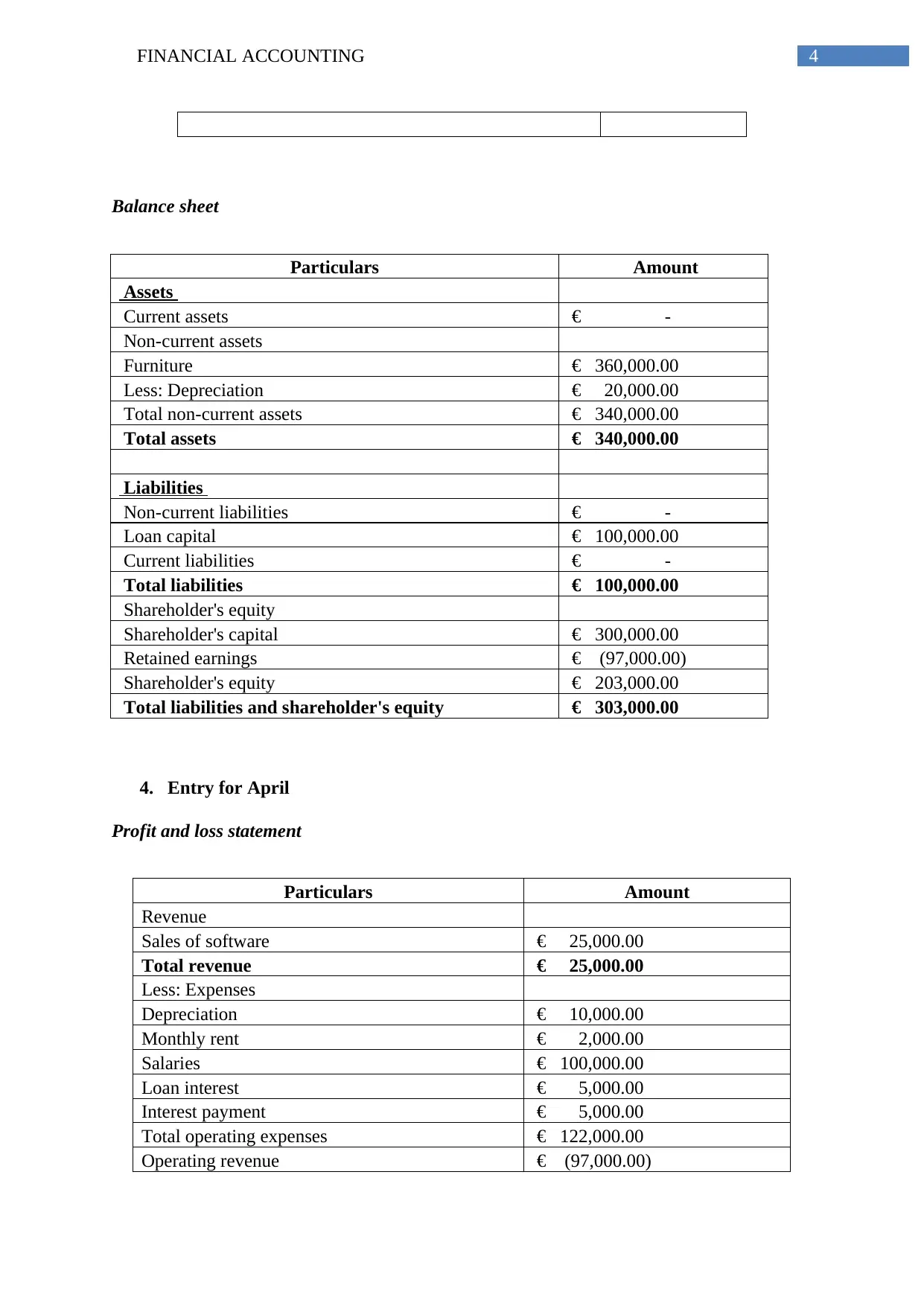
4FINANCIAL ACCOUNTING
Balance sheet
Particulars Amount
Assets
Current assets € -
Non-current assets
Furniture € 360,000.00
Less: Depreciation € 20,000.00
Total non-current assets € 340,000.00
Total assets € 340,000.00
Liabilities
Non-current liabilities € -
Loan capital € 100,000.00
Current liabilities € -
Total liabilities € 100,000.00
Shareholder's equity
Shareholder's capital € 300,000.00
Retained earnings € (97,000.00)
Shareholder's equity € 203,000.00
Total liabilities and shareholder's equity € 303,000.00
4. Entry for April
Profit and loss statement
Particulars Amount
Revenue
Sales of software € 25,000.00
Total revenue € 25,000.00
Less: Expenses
Depreciation € 10,000.00
Monthly rent € 2,000.00
Salaries € 100,000.00
Loan interest € 5,000.00
Interest payment € 5,000.00
Total operating expenses € 122,000.00
Operating revenue € (97,000.00)
Balance sheet
Particulars Amount
Assets
Current assets € -
Non-current assets
Furniture € 360,000.00
Less: Depreciation € 20,000.00
Total non-current assets € 340,000.00
Total assets € 340,000.00
Liabilities
Non-current liabilities € -
Loan capital € 100,000.00
Current liabilities € -
Total liabilities € 100,000.00
Shareholder's equity
Shareholder's capital € 300,000.00
Retained earnings € (97,000.00)
Shareholder's equity € 203,000.00
Total liabilities and shareholder's equity € 303,000.00
4. Entry for April
Profit and loss statement
Particulars Amount
Revenue
Sales of software € 25,000.00
Total revenue € 25,000.00
Less: Expenses
Depreciation € 10,000.00
Monthly rent € 2,000.00
Salaries € 100,000.00
Loan interest € 5,000.00
Interest payment € 5,000.00
Total operating expenses € 122,000.00
Operating revenue € (97,000.00)
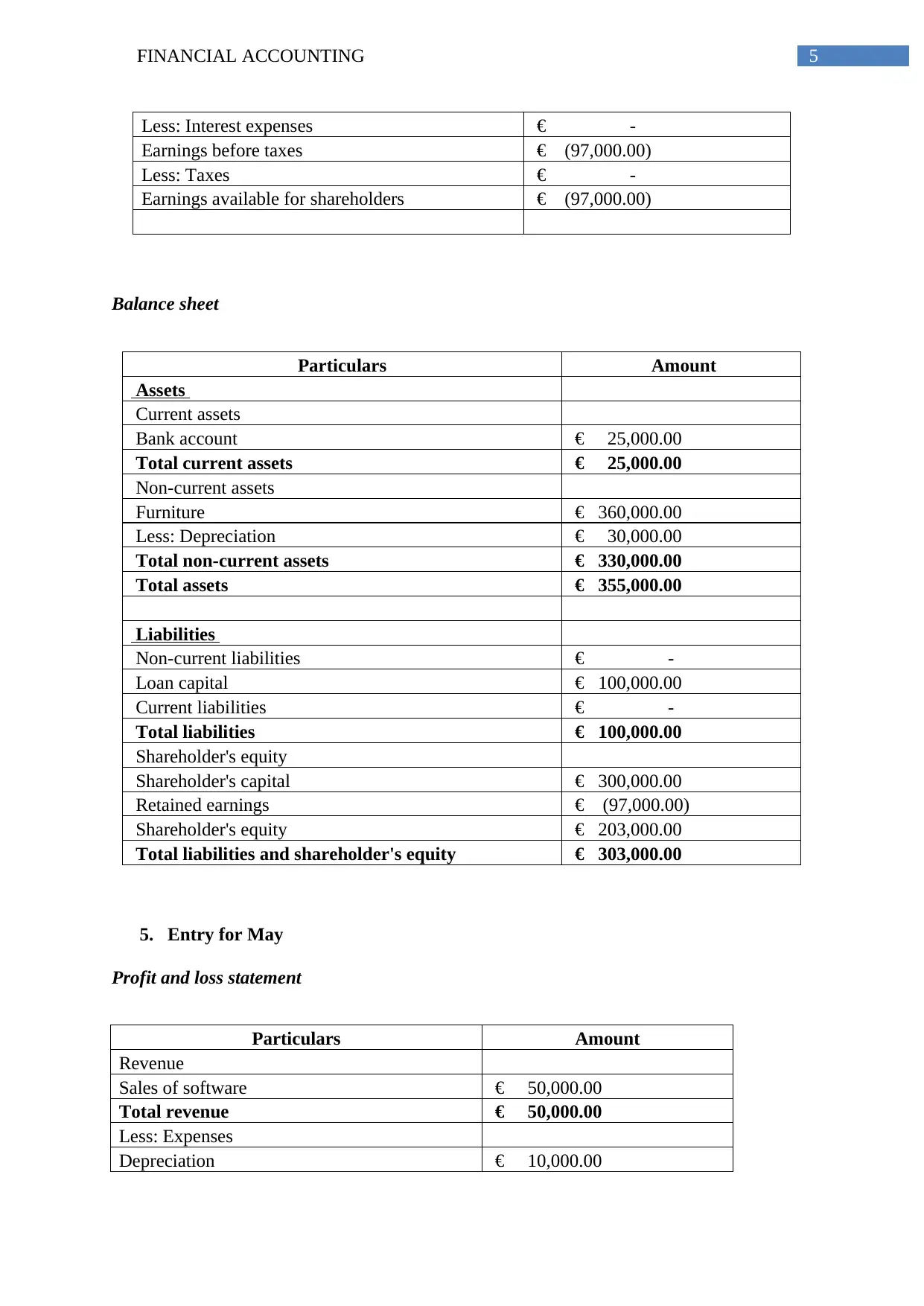
5FINANCIAL ACCOUNTING
Less: Interest expenses € -
Earnings before taxes € (97,000.00)
Less: Taxes € -
Earnings available for shareholders € (97,000.00)
Balance sheet
Particulars Amount
Assets
Current assets
Bank account € 25,000.00
Total current assets € 25,000.00
Non-current assets
Furniture € 360,000.00
Less: Depreciation € 30,000.00
Total non-current assets € 330,000.00
Total assets € 355,000.00
Liabilities
Non-current liabilities € -
Loan capital € 100,000.00
Current liabilities € -
Total liabilities € 100,000.00
Shareholder's equity
Shareholder's capital € 300,000.00
Retained earnings € (97,000.00)
Shareholder's equity € 203,000.00
Total liabilities and shareholder's equity € 303,000.00
5. Entry for May
Profit and loss statement
Particulars Amount
Revenue
Sales of software € 50,000.00
Total revenue € 50,000.00
Less: Expenses
Depreciation € 10,000.00
Less: Interest expenses € -
Earnings before taxes € (97,000.00)
Less: Taxes € -
Earnings available for shareholders € (97,000.00)
Balance sheet
Particulars Amount
Assets
Current assets
Bank account € 25,000.00
Total current assets € 25,000.00
Non-current assets
Furniture € 360,000.00
Less: Depreciation € 30,000.00
Total non-current assets € 330,000.00
Total assets € 355,000.00
Liabilities
Non-current liabilities € -
Loan capital € 100,000.00
Current liabilities € -
Total liabilities € 100,000.00
Shareholder's equity
Shareholder's capital € 300,000.00
Retained earnings € (97,000.00)
Shareholder's equity € 203,000.00
Total liabilities and shareholder's equity € 303,000.00
5. Entry for May
Profit and loss statement
Particulars Amount
Revenue
Sales of software € 50,000.00
Total revenue € 50,000.00
Less: Expenses
Depreciation € 10,000.00
⊘ This is a preview!⊘
Do you want full access?
Subscribe today to unlock all pages.

Trusted by 1+ million students worldwide
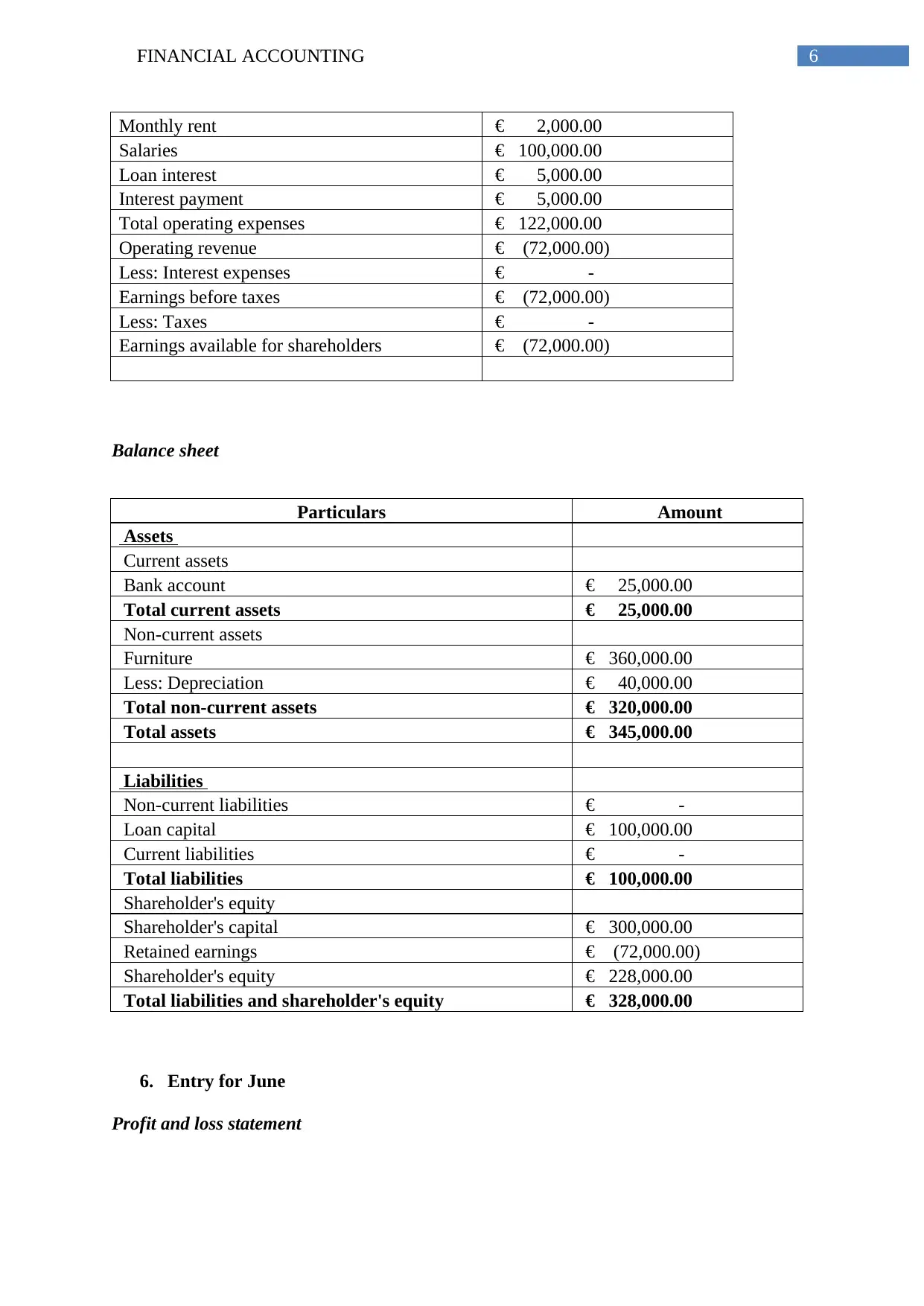
6FINANCIAL ACCOUNTING
Monthly rent € 2,000.00
Salaries € 100,000.00
Loan interest € 5,000.00
Interest payment € 5,000.00
Total operating expenses € 122,000.00
Operating revenue € (72,000.00)
Less: Interest expenses € -
Earnings before taxes € (72,000.00)
Less: Taxes € -
Earnings available for shareholders € (72,000.00)
Balance sheet
Particulars Amount
Assets
Current assets
Bank account € 25,000.00
Total current assets € 25,000.00
Non-current assets
Furniture € 360,000.00
Less: Depreciation € 40,000.00
Total non-current assets € 320,000.00
Total assets € 345,000.00
Liabilities
Non-current liabilities € -
Loan capital € 100,000.00
Current liabilities € -
Total liabilities € 100,000.00
Shareholder's equity
Shareholder's capital € 300,000.00
Retained earnings € (72,000.00)
Shareholder's equity € 228,000.00
Total liabilities and shareholder's equity € 328,000.00
6. Entry for June
Profit and loss statement
Monthly rent € 2,000.00
Salaries € 100,000.00
Loan interest € 5,000.00
Interest payment € 5,000.00
Total operating expenses € 122,000.00
Operating revenue € (72,000.00)
Less: Interest expenses € -
Earnings before taxes € (72,000.00)
Less: Taxes € -
Earnings available for shareholders € (72,000.00)
Balance sheet
Particulars Amount
Assets
Current assets
Bank account € 25,000.00
Total current assets € 25,000.00
Non-current assets
Furniture € 360,000.00
Less: Depreciation € 40,000.00
Total non-current assets € 320,000.00
Total assets € 345,000.00
Liabilities
Non-current liabilities € -
Loan capital € 100,000.00
Current liabilities € -
Total liabilities € 100,000.00
Shareholder's equity
Shareholder's capital € 300,000.00
Retained earnings € (72,000.00)
Shareholder's equity € 228,000.00
Total liabilities and shareholder's equity € 328,000.00
6. Entry for June
Profit and loss statement
Paraphrase This Document
Need a fresh take? Get an instant paraphrase of this document with our AI Paraphraser
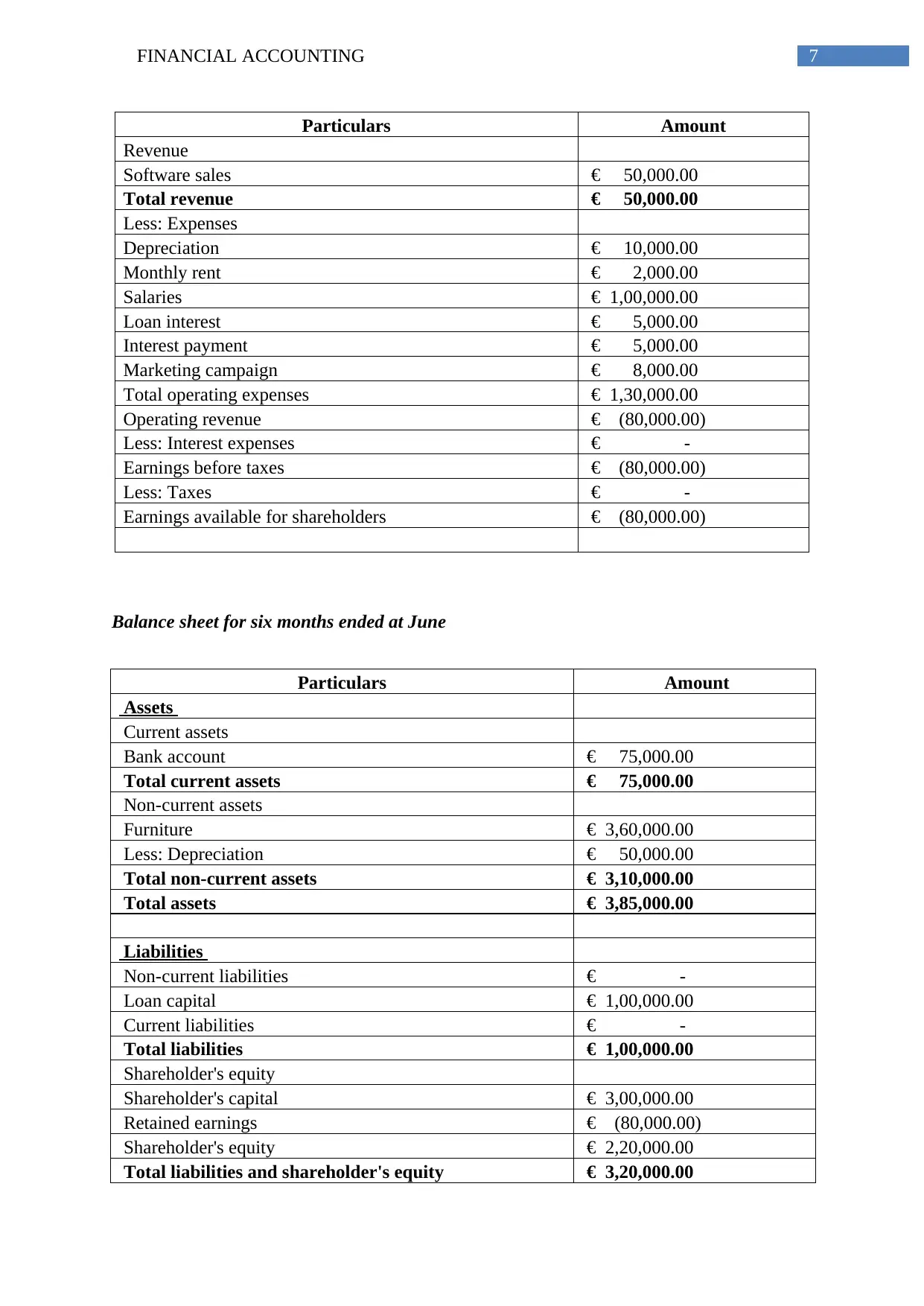
7FINANCIAL ACCOUNTING
Particulars Amount
Revenue
Software sales € 50,000.00
Total revenue € 50,000.00
Less: Expenses
Depreciation € 10,000.00
Monthly rent € 2,000.00
Salaries € 1,00,000.00
Loan interest € 5,000.00
Interest payment € 5,000.00
Marketing campaign € 8,000.00
Total operating expenses € 1,30,000.00
Operating revenue € (80,000.00)
Less: Interest expenses € -
Earnings before taxes € (80,000.00)
Less: Taxes € -
Earnings available for shareholders € (80,000.00)
Balance sheet for six months ended at June
Particulars Amount
Assets
Current assets
Bank account € 75,000.00
Total current assets € 75,000.00
Non-current assets
Furniture € 3,60,000.00
Less: Depreciation € 50,000.00
Total non-current assets € 3,10,000.00
Total assets € 3,85,000.00
Liabilities
Non-current liabilities € -
Loan capital € 1,00,000.00
Current liabilities € -
Total liabilities € 1,00,000.00
Shareholder's equity
Shareholder's capital € 3,00,000.00
Retained earnings € (80,000.00)
Shareholder's equity € 2,20,000.00
Total liabilities and shareholder's equity € 3,20,000.00
Particulars Amount
Revenue
Software sales € 50,000.00
Total revenue € 50,000.00
Less: Expenses
Depreciation € 10,000.00
Monthly rent € 2,000.00
Salaries € 1,00,000.00
Loan interest € 5,000.00
Interest payment € 5,000.00
Marketing campaign € 8,000.00
Total operating expenses € 1,30,000.00
Operating revenue € (80,000.00)
Less: Interest expenses € -
Earnings before taxes € (80,000.00)
Less: Taxes € -
Earnings available for shareholders € (80,000.00)
Balance sheet for six months ended at June
Particulars Amount
Assets
Current assets
Bank account € 75,000.00
Total current assets € 75,000.00
Non-current assets
Furniture € 3,60,000.00
Less: Depreciation € 50,000.00
Total non-current assets € 3,10,000.00
Total assets € 3,85,000.00
Liabilities
Non-current liabilities € -
Loan capital € 1,00,000.00
Current liabilities € -
Total liabilities € 1,00,000.00
Shareholder's equity
Shareholder's capital € 3,00,000.00
Retained earnings € (80,000.00)
Shareholder's equity € 2,20,000.00
Total liabilities and shareholder's equity € 3,20,000.00

8FINANCIAL ACCOUNTING
⊘ This is a preview!⊘
Do you want full access?
Subscribe today to unlock all pages.

Trusted by 1+ million students worldwide
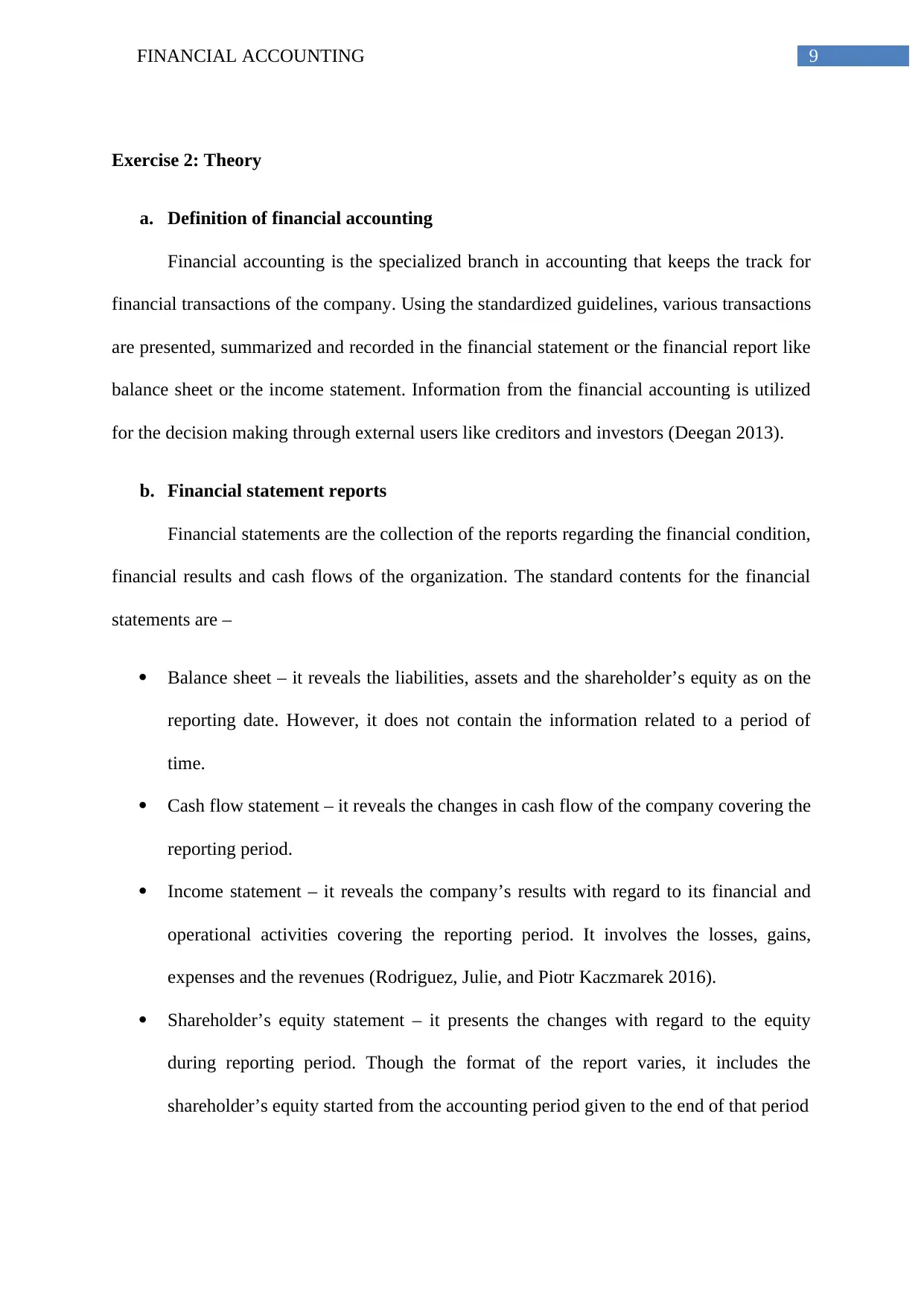
9FINANCIAL ACCOUNTING
Exercise 2: Theory
a. Definition of financial accounting
Financial accounting is the specialized branch in accounting that keeps the track for
financial transactions of the company. Using the standardized guidelines, various transactions
are presented, summarized and recorded in the financial statement or the financial report like
balance sheet or the income statement. Information from the financial accounting is utilized
for the decision making through external users like creditors and investors (Deegan 2013).
b. Financial statement reports
Financial statements are the collection of the reports regarding the financial condition,
financial results and cash flows of the organization. The standard contents for the financial
statements are –
Balance sheet – it reveals the liabilities, assets and the shareholder’s equity as on the
reporting date. However, it does not contain the information related to a period of
time.
Cash flow statement – it reveals the changes in cash flow of the company covering the
reporting period.
Income statement – it reveals the company’s results with regard to its financial and
operational activities covering the reporting period. It involves the losses, gains,
expenses and the revenues (Rodriguez, Julie, and Piotr Kaczmarek 2016).
Shareholder’s equity statement – it presents the changes with regard to the equity
during reporting period. Though the format of the report varies, it includes the
shareholder’s equity started from the accounting period given to the end of that period
Exercise 2: Theory
a. Definition of financial accounting
Financial accounting is the specialized branch in accounting that keeps the track for
financial transactions of the company. Using the standardized guidelines, various transactions
are presented, summarized and recorded in the financial statement or the financial report like
balance sheet or the income statement. Information from the financial accounting is utilized
for the decision making through external users like creditors and investors (Deegan 2013).
b. Financial statement reports
Financial statements are the collection of the reports regarding the financial condition,
financial results and cash flows of the organization. The standard contents for the financial
statements are –
Balance sheet – it reveals the liabilities, assets and the shareholder’s equity as on the
reporting date. However, it does not contain the information related to a period of
time.
Cash flow statement – it reveals the changes in cash flow of the company covering the
reporting period.
Income statement – it reveals the company’s results with regard to its financial and
operational activities covering the reporting period. It involves the losses, gains,
expenses and the revenues (Rodriguez, Julie, and Piotr Kaczmarek 2016).
Shareholder’s equity statement – it presents the changes with regard to the equity
during reporting period. Though the format of the report varies, it includes the
shareholder’s equity started from the accounting period given to the end of that period
Paraphrase This Document
Need a fresh take? Get an instant paraphrase of this document with our AI Paraphraser
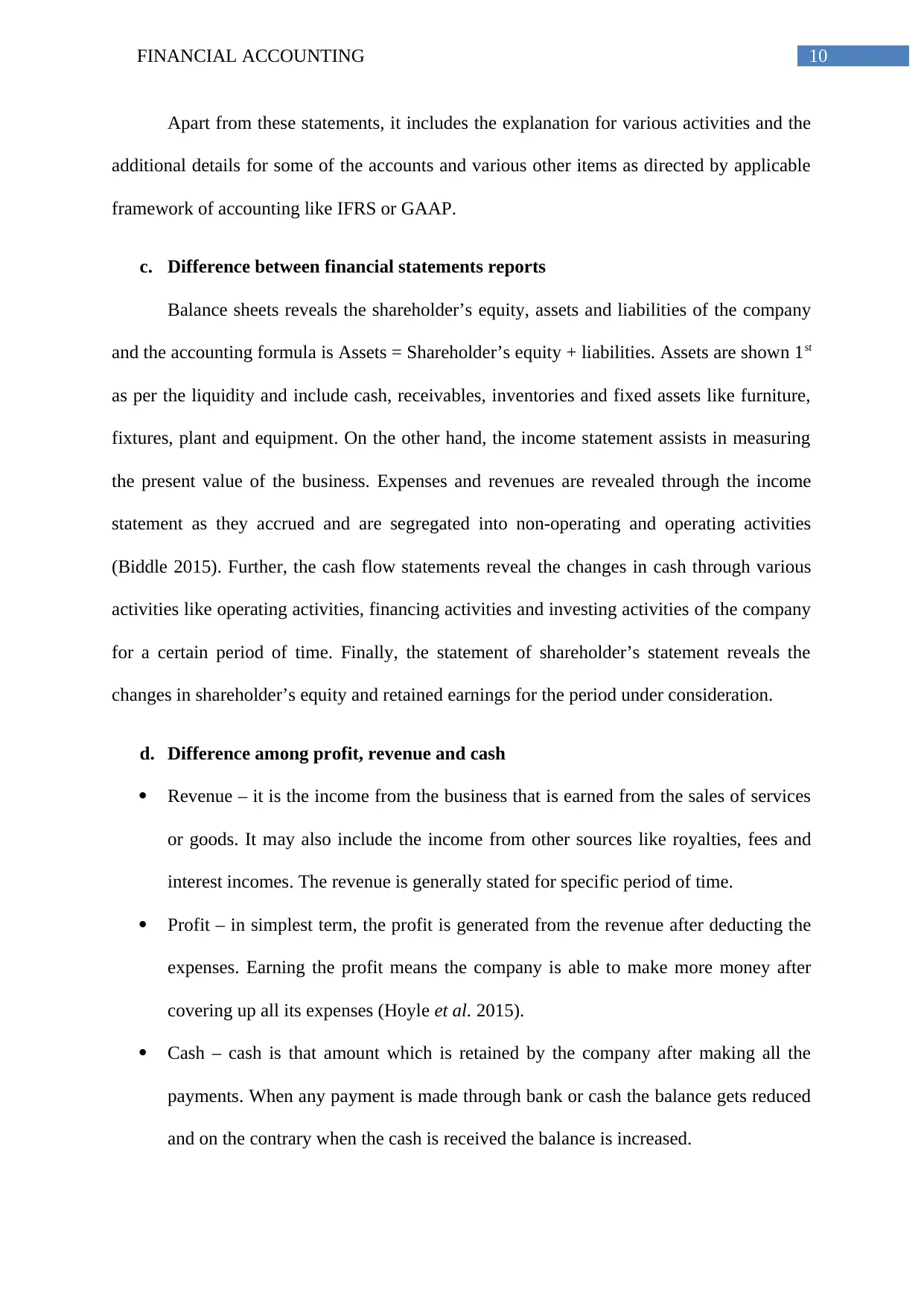
10FINANCIAL ACCOUNTING
Apart from these statements, it includes the explanation for various activities and the
additional details for some of the accounts and various other items as directed by applicable
framework of accounting like IFRS or GAAP.
c. Difference between financial statements reports
Balance sheets reveals the shareholder’s equity, assets and liabilities of the company
and the accounting formula is Assets = Shareholder’s equity + liabilities. Assets are shown 1st
as per the liquidity and include cash, receivables, inventories and fixed assets like furniture,
fixtures, plant and equipment. On the other hand, the income statement assists in measuring
the present value of the business. Expenses and revenues are revealed through the income
statement as they accrued and are segregated into non-operating and operating activities
(Biddle 2015). Further, the cash flow statements reveal the changes in cash through various
activities like operating activities, financing activities and investing activities of the company
for a certain period of time. Finally, the statement of shareholder’s statement reveals the
changes in shareholder’s equity and retained earnings for the period under consideration.
d. Difference among profit, revenue and cash
Revenue – it is the income from the business that is earned from the sales of services
or goods. It may also include the income from other sources like royalties, fees and
interest incomes. The revenue is generally stated for specific period of time.
Profit – in simplest term, the profit is generated from the revenue after deducting the
expenses. Earning the profit means the company is able to make more money after
covering up all its expenses (Hoyle et al. 2015).
Cash – cash is that amount which is retained by the company after making all the
payments. When any payment is made through bank or cash the balance gets reduced
and on the contrary when the cash is received the balance is increased.
Apart from these statements, it includes the explanation for various activities and the
additional details for some of the accounts and various other items as directed by applicable
framework of accounting like IFRS or GAAP.
c. Difference between financial statements reports
Balance sheets reveals the shareholder’s equity, assets and liabilities of the company
and the accounting formula is Assets = Shareholder’s equity + liabilities. Assets are shown 1st
as per the liquidity and include cash, receivables, inventories and fixed assets like furniture,
fixtures, plant and equipment. On the other hand, the income statement assists in measuring
the present value of the business. Expenses and revenues are revealed through the income
statement as they accrued and are segregated into non-operating and operating activities
(Biddle 2015). Further, the cash flow statements reveal the changes in cash through various
activities like operating activities, financing activities and investing activities of the company
for a certain period of time. Finally, the statement of shareholder’s statement reveals the
changes in shareholder’s equity and retained earnings for the period under consideration.
d. Difference among profit, revenue and cash
Revenue – it is the income from the business that is earned from the sales of services
or goods. It may also include the income from other sources like royalties, fees and
interest incomes. The revenue is generally stated for specific period of time.
Profit – in simplest term, the profit is generated from the revenue after deducting the
expenses. Earning the profit means the company is able to make more money after
covering up all its expenses (Hoyle et al. 2015).
Cash – cash is that amount which is retained by the company after making all the
payments. When any payment is made through bank or cash the balance gets reduced
and on the contrary when the cash is received the balance is increased.
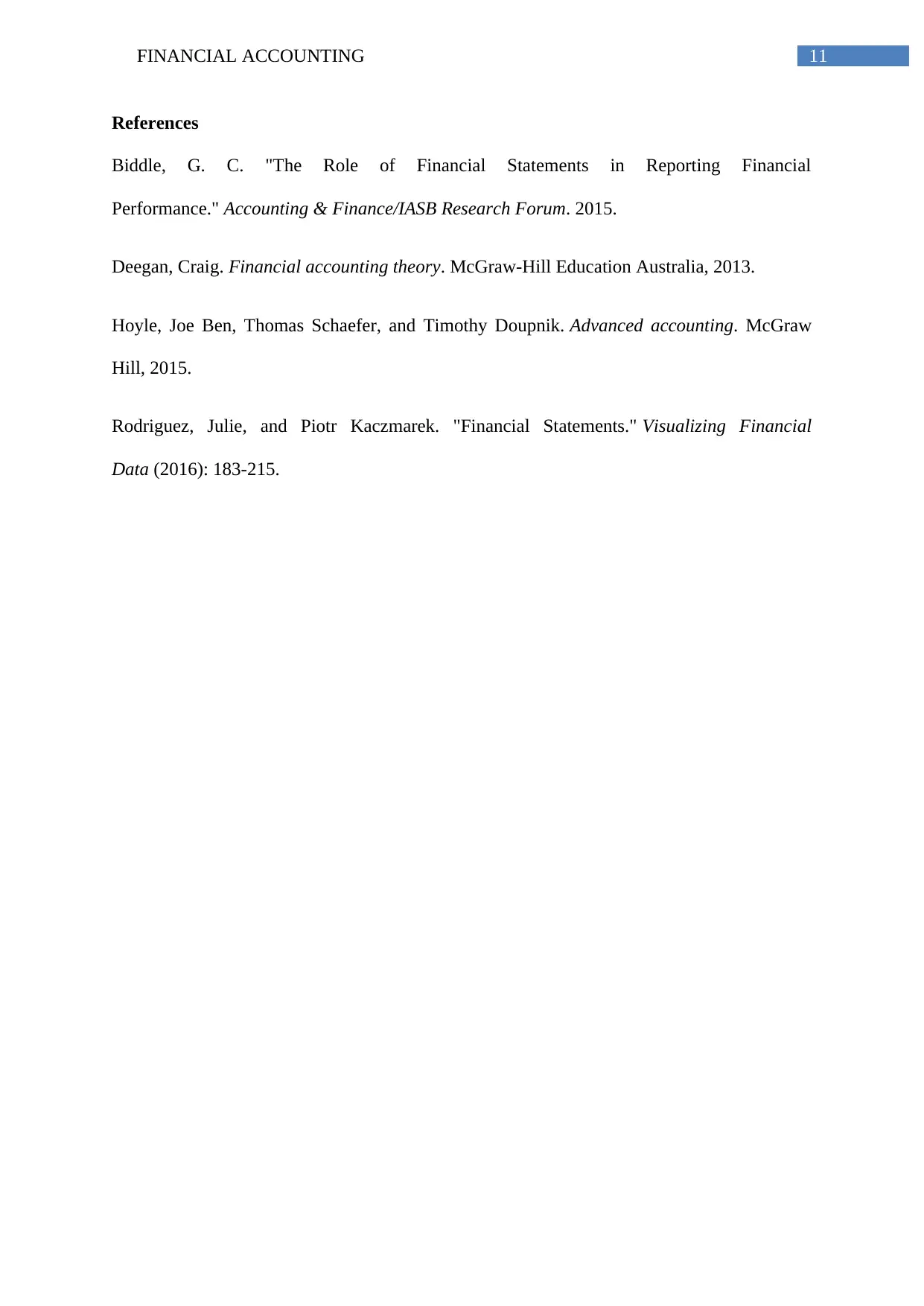
11FINANCIAL ACCOUNTING
References
Biddle, G. C. "The Role of Financial Statements in Reporting Financial
Performance." Accounting & Finance/IASB Research Forum. 2015.
Deegan, Craig. Financial accounting theory. McGraw-Hill Education Australia, 2013.
Hoyle, Joe Ben, Thomas Schaefer, and Timothy Doupnik. Advanced accounting. McGraw
Hill, 2015.
Rodriguez, Julie, and Piotr Kaczmarek. "Financial Statements." Visualizing Financial
Data (2016): 183-215.
References
Biddle, G. C. "The Role of Financial Statements in Reporting Financial
Performance." Accounting & Finance/IASB Research Forum. 2015.
Deegan, Craig. Financial accounting theory. McGraw-Hill Education Australia, 2013.
Hoyle, Joe Ben, Thomas Schaefer, and Timothy Doupnik. Advanced accounting. McGraw
Hill, 2015.
Rodriguez, Julie, and Piotr Kaczmarek. "Financial Statements." Visualizing Financial
Data (2016): 183-215.
⊘ This is a preview!⊘
Do you want full access?
Subscribe today to unlock all pages.

Trusted by 1+ million students worldwide
1 out of 12
Related Documents
Your All-in-One AI-Powered Toolkit for Academic Success.
+13062052269
info@desklib.com
Available 24*7 on WhatsApp / Email
![[object Object]](/_next/static/media/star-bottom.7253800d.svg)
Unlock your academic potential
Copyright © 2020–2025 A2Z Services. All Rights Reserved. Developed and managed by ZUCOL.





